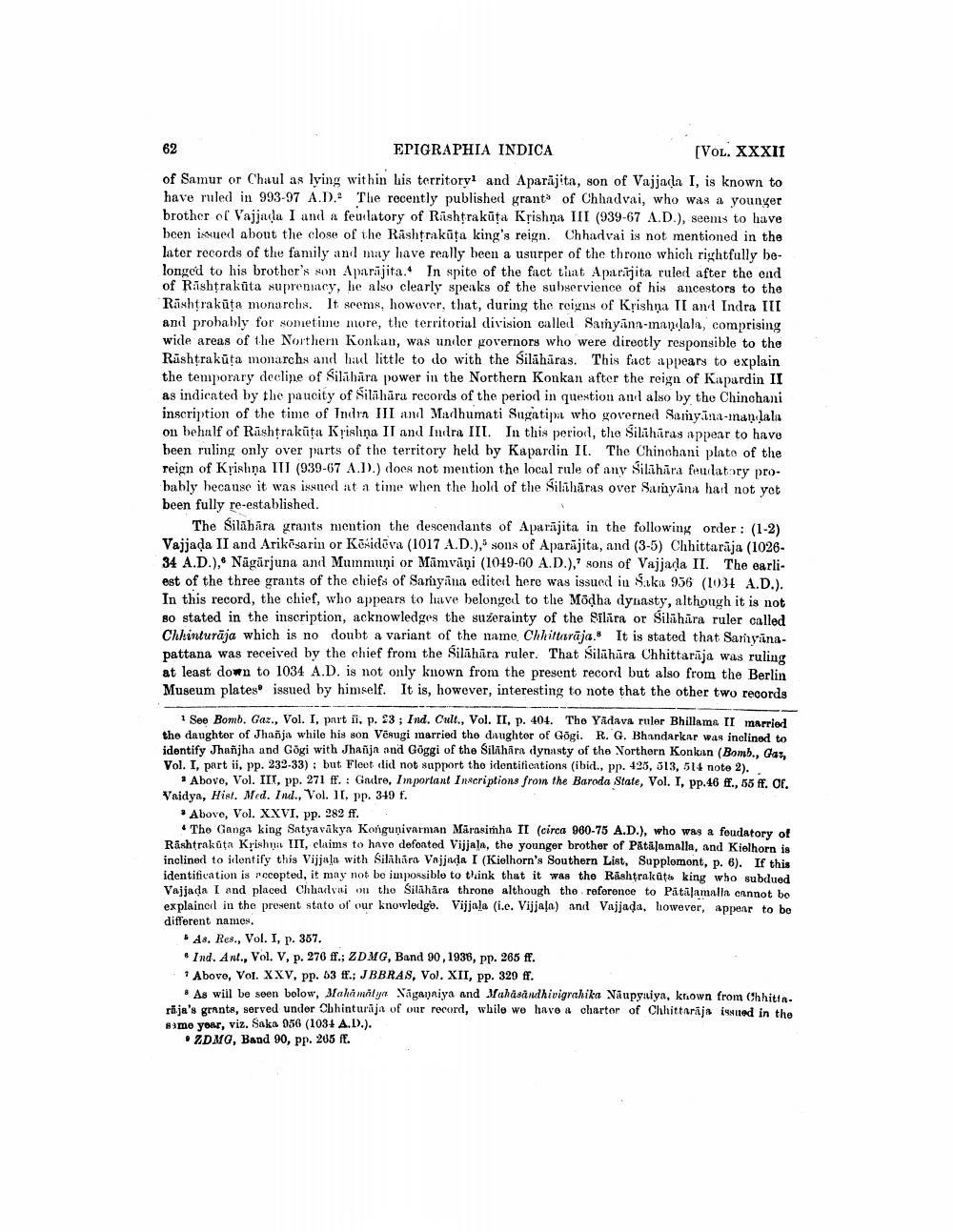________________
62
EPIGRAPHIA INDICA
[VOL. XXXII
of Samur or Chaul as lying within his territory and Aparajita, son of Vajjada I, is known to have ruled in 993-97 A.D. The recently published grants of Chhadvai, who was a younger brother of Vajjada I and a feudatory of Rashtrakuta Krishna III (939-67 A.D.), seems to have been issued about the close of the Rashtrakuta king's reign. Chhadvai is not mentioned in the later records of the family and may have really been a usurper of the throne which rightfully belonged to his brother's son Aparajita. In spite of the fact that Aparajita ruled after the end of Rashtrakuta supremacy, he also clearly speaks of the subservience of his ancestors to the Rashtrakuta monarchs. It seems, however, that, during the reigns of Krishna II and Indra III and probably for sometime more, the territorial division called Samyana-mandala, comprising wide areas of the Northern Konkan, was under governors who were directly responsible to the Rashtrakuta monarchs and had little to do with the Silähäras. This fact appears to explain the temporary decline of Silahara power in the Northern Konkan after the reign of Kapardin II as indicated by the paucity of Silahara records of the period in question and also by the Chinchani inscription of the time of Indra III and Madhumati Sugatipa who governed Samyana-manlala on behalf of Rashtrakuta Krishna II and Indra III. In this period, the Silähäras appear to have been ruling only over parts of the territory held by Kapardin II. The Chinchani plate of the reign of Krishna III (939-67 A.1).) does not mention the local rule of any Silahara feudatory probably because it was issued at a time when the hold of the Silahāras over Saiyana had not yet been fully re-established.
The Silahara grants mention the descendants of Aparajita in the following order: (1-2) Vajjada II and Arikesarin or Kesideva (1017 A.D.), sons of Aparajita, and (3-5) Chhittaraja (102634 A.D.), Nägürjuna and Mummuņi or Māmvāņi (1049-60 A.D.), sons of Vajjada II. The earliest of the three grants of the chiefs of Saryana edited here was issued in Saka 956 (1034 A.D.). In this record, the chief, who appears to have belonged to the Modha dynasty, although it is not so stated in the inscription, acknowledges the suzerainty of the Silara or Silahara ruler called Chhinturaja which is no doubt a variant of the name Chhittaraja. It is stated that Samyanapattana was received by the chief from the Silahara ruler. That Silahara Chhittaraja was ruling at least down to 1034 A.D. is not only known from the present record but also from the Berlin Museum plates issued by himself. It is, however, interesting to note that the other two records
1 See Bomb. Gaz., Vol. I, part ii, p. 23; Ind. Cult., Vol. II, p. 404. The Yadava ruler Bhillams II married the daughter of Jhañja while his son Vêsugi married the daughter of Gogi. R. G. Bhandarkar was inclined to identify Jhanjha and Gogi with Jhañja and Goggi of the Silahara dynasty of the Northern Konkan (Bomb., Gar, Vol. I, part ii, pp. 232-33); but Fleet did not support the identifications (ibid., pp. 425, 513, 514 note 2).
Above, Vol. III, pp. 271 ff.: Gadre, Important Inscriptions from the Baroda State, Vol. I, pp.46 ff., 55 ff. Of. Vaidya, Hist. Med. Ind., Vol. II, pp. 349 f..
Above, Vol. XXVI, pp. 282 ff.
The Ganga king Satyavakya Kongunivarman Marasimha II (circa 960-75 A.D.), who was a feudatory of Rashtrakuta Krishna III, claims to have defeated Vijjala, the younger brother of Pätālamalla, and Kielhorn is inclined to identify this Vijjala with Silahara Vajjada I (Kielhorn's Southern List, Supplemont, p. 6). If this identification is recopted, it may not be impossible to think that it was the Rashtrakuta king who subdued Vajjada I and placed Chhadvai on the Silahara throne although the reference to Pätälamalla cannot be explained in the present stato of our knowledge. Vijjala (i.e. Vijjala) and Vajjada, however, appear to be different names.
As. Res., Vol. I, p. 357.
Ind. Ant., Vol. V, p. 276 ff.; ZDMG, Band 90, 1936, pp. 265 ff.
Above, Vol. XXV, pp. 63 ff.; JBBRAS, Vol. XII, pp. 329 ff.
As will be seen below, Mahamatya Naganaiya and Mahäsändhivigrahika Naupyaiya, known from Chhittaraja's grants, served under Chhinturaja of our record, while we have a charter of Chhittaraja issued in the same year, viz. Saka 956 (1034 A.D.).
• ZDMG, Band 90, pp. 205 ff.




